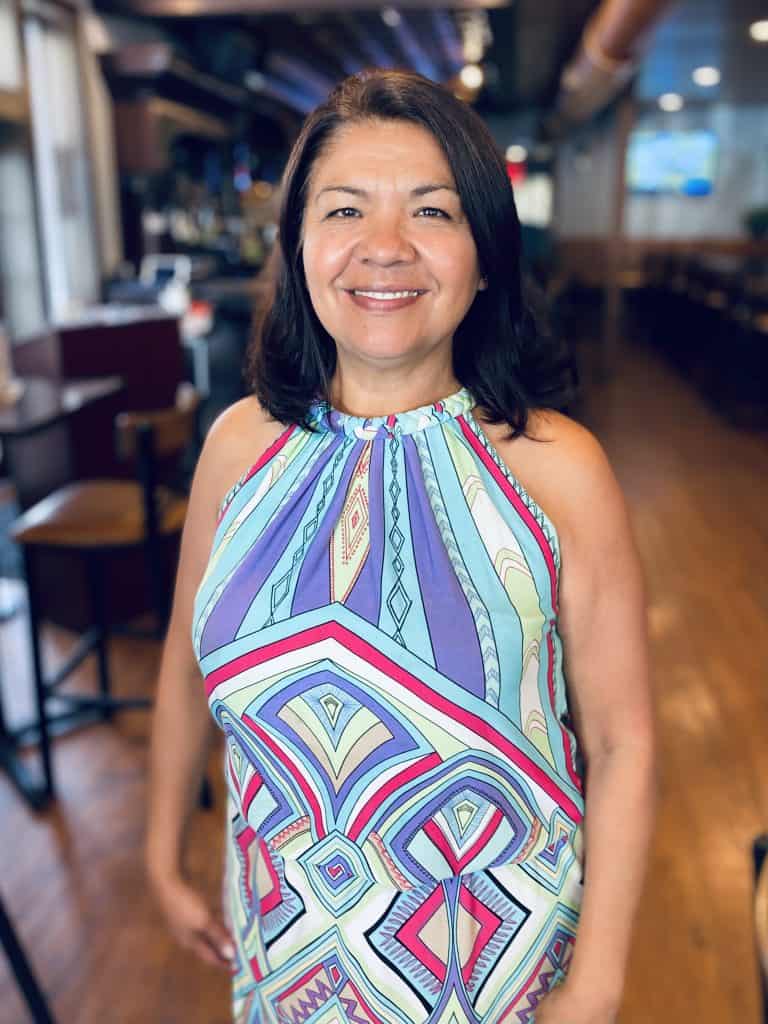A couple enters through one of the two wood-framed double doors, glances around the crowded spacious casual style dining restaurant for open tables, and decides on a spot for two in the patio offered to them by Marci Berner co-owner of Tata’s Tacos in Lakeview
It’s the second “authentic American food with a Mexican flavor” eatery – as Berner calls it, that she opened on the North Side. The first Tata’s Tacos to serve the tasty hand-sized dishes welcomed patrons in Portage Park in 2018.

Like most restaurateurs, Berner and her partner made difficult decisions last year due to the coronavirus pandemic. “Takeout and delivery became a big part of the business,” she says.
Still, while others struggled to survive, Berner saw an opportunity to thrive. “We either go big or go home,” remembering a conversation with her partner that resulted in expanding their business in January.
Berner says she found a motivated landlord willing to negotiate a deal that made sense for both parties in an uncertain economic climate with abundant vacant commercial space. But, to succeed, she says one has to be courageous and creative. Two traits she credits her mother instilling in her; an immigrant from Michoacán, Mexico, who brought her family to Chicago nearly five decades ago.
“Chicago is still the land of opportunity,” Berner asserts.
Latino Population Surge
Hispanics-Latinos who think like Berner is what propelled the group in becoming Chicago’s second-largest racial or ethnic group, according to the U.S. Census Bureau.
The group now represents nearly 30-percent of the city’s residents, with an increase in the population of approximately 41,000. The largest groups are from or have Mexican and Puerto Rican roots, followed by people from Central and South America and the Caribbean.
The 2020 census numbers released this month also show a rise in the Hispanic-Latino population in suburban Cook County and Illinois, up by almost 100,000 and 310,000, respectively.
Hispanics-Latinos represent 18.2-percent of the state’s population with 2.3 million, an increase of 15-percent over ten years.
Contrary to popular belief, the forces behind the group’s growth are births and not immigration. The share of U.S. Hispanics-Latinos who are immigrants is on the decline, reports the Pew Research Center. From 2007 to 2018, the number of Latino immigrants in this country increased slightly, from 18 million to 19.8 million data reveals. But they made up a declining share of the Hispanic-Latino population – 40-percent to 33-percent during this span as the number of births climbed.
Regardless of the Hispanic-Latino population’s growth, economic opportunities are not keeping up with their needs.
Disproportionate Economic Impact
According to the United States Hispanic Chamber of Commerce, there are nearly 5 million Hispanic-Latino-owned businesses in the U.S. One hundred twenty thousand are right here in Illinois; 80-percent operate in the Chicago metropolitan area. Together they contribute more than $700 billion to the American economy each year. In addition, Hispanics-Latinos start 75-percent of new businesses in the United States.
Still, they remain smaller than white-owned companies, are denied loans more often than their white counterparts, and as a result, are vulnerable to predatory lending generating insurmountable debt.
Structural and institutional racism keeping Hispanics-Latinos from acquiring wealth before the pandemic hit has only worsened the economic crisis for this community.
When Governor Pritzker gave the Stay at Home order on March 21, 2020, it set small businesses back, but none more so than Hispanic-Latino-owned businesses.
According to a report by McKinsey & Company, a management consulting firm founded in Chicago, the five business sectors most affected by COVID-19-related shutdowns (leisure and hospitality, retail, transportation, construction, and ‘other’) generate almost 50-percent of the revenues of all Hispanic-Latino-owned businesses.
“Banquet halls that are normally booked months in advance for weddings and quinceañeras practically shut down overnight,” says Jaime di Paulo, President & CEO of the Illinois Hispanic Chamber of Commerce (IHCC). Quinceañera, a celebration of a girl’s 15th birthday with cultural roots in Mexico that typically welcomes up to 300 guests, was canceled, the number of guests significantly reduced due to social distancing guidelines, or reinvented as outdoor drive-thru events.
Due to Hispanic-Latino workers being overrepresented in industries hardest hit by the pandemic, unemployment rates skyrocketed for this group, accounting for more than 20-percent of the initial job loss nationally. In addition, Hispanic-Latina women alone represented 45-percent of job losses in December, reported the U.S. Bureau of Labor Statistics. In May, the agency also revealed that the unemployment rate for Hispanics-Latinos rose to an estimated more than 4 million people – a rate higher than any other racial or ethnic group.
The COVID-19 government relief that primarily worked through banks left Hispanic-Latino businesses — out.
Not All Help Is Equal
The Paycheck Protection Program (PPP), first established in the spring of 2020, disproportionately favored white business owners with ties to big banks. An April 2020 survey by the League of United Latin American Citizens of more than 500 Hispanic-Latino small-business owners who applied for pandemic relief loans found that less than 100 got them.
“When the federal money came here to Chicago, we know that traditionally, businesses that had banking relationships with the small business administration who pushed out the money, those were first in line.” Chicago Department of Business and Consumer Protection Commissioner Rosa Escareño said before retiring. “Those are not the businesses in our (Latino) neighborhoods.”
Another challenge was that PPP loans required small businesses to borrow money from the federal government to keep staff on the payroll. As a result, their costs, which included incremental dollars for personal protective equipment, exceeded their revenues, creating a negative cash flow that’s just not sustainable long-term.
“The majority of Hispanic-owned businesses in Chicago employ fewer than 20 people,” says di Paulo. “They’re busy running their business and not necessarily their books.” Di Paulo says the IHCC spent more than 14,000 hours of counseling serving about 11,000 business owners and entrepreneurs in getting $80 million in grants in 2020.
Chef Margarita Challenger, co-owner of Tacos Guanajuato restaurant in Kildeer, applied for two PPP loans and was fortunate enough to get one. The funding helped her keep her staff employed. “I’m grateful for the (financial) help – without it, we wouldn’t be here,” she says.
Challenger, who named her restaurant after the Mexican city she grew up in, pivoted to a takeout operation at the height of the pandemic and expanded the restaurant’s outdoor patio to accommodate COVID-19 mitigation measures. “Great dishes and a healthy and safe environment is a priority.”
Challenger and Berner exemplify the community’s resilience despite the many setbacks Hispanic-Latino-owned businesses endure due to COVID-19. When asked if she is concerned about the City reverting to restrictions similar to last year, Berner says, “There’s no system that catches us. So I’ll do what I need to do to keep going, make it happen.”
Cover Photo: Tata’s Tacos outdoor patio, Lakeview
Census 2020: “Chicago Is Still The Land Of Opportunity” was first published in The Chicago Reporter.
ILLatinoNews partners with The Chicago Reporter in best serving the Hispanic-Latino communities of Illinois.




